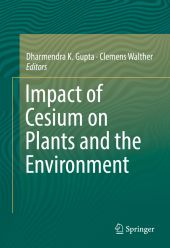 Neuerscheinungen 2016Stand: 2020-02-01 |
Schnellsuche
ISBN/Stichwort/Autor
|
Herderstraße 10
10625 Berlin
Tel.: 030 315 714 16
Fax 030 315 714 14
info@buchspektrum.de |

Dharmendra Gupta, Clemens Walther
(Beteiligte)
Impact of Cesium on Plants and the Environment
Herausgegeben von Gupta, Dharmendra; Walther, Clemens
1st ed. 2017. 2016. x, 319 S. 33 SW-Abb., 28 Farbabb., 28 Farbtabellen. 235 mm
Verlag/Jahr: SPRINGER, BERLIN; SPRINGER INTERNATIONAL PUBLISHING 2016
ISBN: 3-319-41524-7 (3319415247)
Neue ISBN: 978-3-319-41524-6 (9783319415246)
Preis und Lieferzeit: Bitte klicken
This book provides extensive and comprehensive knowledge to the researchers/academics who are working in the field of cesium contaminated sites, and the impact on plants. This book is also helpful for graduate and undergraduate students who are specializing in radioecology or safe disposal of radioactive waste, remediation of legacies and the impact on the environment. Radiocesium ( 137 Cs and 134 Cs) was released into the environment as a result of nuclear weapons testing in 1950s and 1960s (~1x10 18 Bq), and later due to the Chernobyl accident in 1986 (8.5x10 16 Bq) and Fukushima Daiichi Nuclear Power Plant in 2011 (~1x10 17 Bq). 137 Cs is still of relevance due to its half-life of 30 years. The study of radioisotope 137 Cs is important, as production and emission rates are high compared to other radioisotopes, due to high fission yield and high volatility.
This book contains original work and reviews on how cesium is released into the environment on translocation from soil to plants and further on to animals and into the human food chain. Separate chapters focus on the effective half-life of cesium in plants and on how different cultivars are responding in accumulation of cesium. Other key chapters focus on cesium impact on single cells to higher plants and also on remediation measures as well as on basic mechanism used for remedial options and analysis of transfer factors. The book rounds off by contributions on cesium uptake and translocation and its toxicity in plants after the Chernobyl and Fukushima accidents.
Distribution of cesium in soil and its uptake by plants.- Factors influencing the soil to plant transfer of radiocaesium.- Role of mycorrhizal fungi in cesium uptake by plants.- Influence of biologically active preparations on Cs-137 transition to plants from soil in the territories contaminated as the result of Chernobyl accident.- The distribution of 137Cs in selected compartments of coniferous forests in the Czech Republic.- Cesium uptake in plants: Mechanism, regulation and application for phytoremediation.- Effective half-lives of radiocesium in terrestrial plants observed after nuclear power plant accidents.- Cultivar difference and fertilizer effects on radioactive cesium accumulation in rice grown in Fukushima paddy field from 2011 to 2014.- Distribution of 137Cs between the components of pine forest of Charnobyl NPP exclusion zone.- Cesium accumulation by aquatic plants and algae.- Regularities of accumulation of Cs-137 and other radionuclides in the aquatic vegetation in the territory of South-Ural biogeochemical province of technogenic radioactive isotopes.- Radiocesium phytotoxicity to single cell and higher plants.- Sorbents for radiocaesium removal from natural water and soil.- Analysis of transfer factor, anatomical changes and growth of plants during phytoremediation of cesium contaminated solutions.- Remediation of areas contaminated by caesium: Basic mechanisms behind remedial options and experience in application.
Dharmendra K. Gupta is Sr. Scientist of Environmental Biotechnology and already published more than 70 refereed research papers/review articles in peer reviewed journals and edited nine books. His field of research includes abiotic stress by heavy metals/radionuclides and xenobiotics in plants; antioxidative system in plants, environmental pollution (heavy metal/radionuclide) remediation through plants (phytoremediation).
Clemens Walther is professor of radioecology and radiation protection and director of the Institute for Radioecology and Radiation Protection at the Leibniz Universität Hannover. He published more than 100 papers in peer reviewed journals. His field of research is actinide chemistry with a focus on solution species and formation of colloids, ultra-trace detection and speciation of radionuclides in the environment by mass spectrometry and laser spectroscopy.


